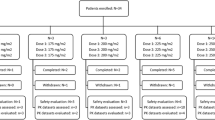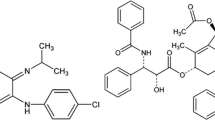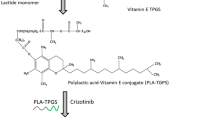Abstract
Purpose: To evaluate in vitro cytotoxicity, in vivo antitumour activity and biodistribution of a novel polymeric (poly(DL-lactide)-block-methoxy polyethylene glycol) micellar paclitaxel. Methods: Hs578T breast, SKMES non-small-cell lung, and HT-29 colon human tumour cells were exposed, either for 1 h or continuously, to conventionally formulated paclitaxel (Cremophor paclitaxel) or polymeric micellar paclitaxel. After a period of incubation, cytotoxicity was measured using a radiometric system. In the in vivo antitumour study, B6D2F1 mice, bearing P388 leukaemia tumour intraperitoneally (i.p.), were treated with polymeric micellar paclitaxel or Cremophor paclitaxel by i.p. injection. The number of deaths and body weights were recorded. In the biodistribution study, CD-1 mice were given micellar paclitaxel i.p. at a dose of 100 mg/kg. The mice were sacrificed after a given time and the organs were harvested. Paclitaxel in the organs was extracted by acetonitrile and analysed using HPLC. Results: The polymeric micellar paclitaxel showed similar in vitro cytotoxicity to Cremophor paclitaxel against the tumour cell lines. The polymeric micellar formulation of paclitaxel produced a fivefold increase in the maximum tolerated dose (MTD) as compared with Cremophor paclitaxel when administered i.p. In addition, micellar paclitaxel was more efficacious in vivo when tested in the murine P388 leukaemia model of malignancy than Cremophor paclitaxel when both were administered i.p. at their MTDs. Micellar paclitaxel-treated animals had an increased survival time and, importantly, long-term survivors (20% of those tested) were obtained only in the polymeric paclitaxel formulation group. Biodistribution studies indicated that a significant amount of paclitaxel could be detected in blood, liver, kidney, spleen, lung and heart of mice after i.p. dosing of the polymeric micellar paclitaxel formulation. Conclusion: These preliminary results indicate that polymeric micellar paclitaxel could be a clinically useful chemotherapeutic formulation.
Similar content being viewed by others
Author information
Authors and Affiliations
Additional information
Received: 18 April 1996 / Accepted: 12 September 1996
Rights and permissions
About this article
Cite this article
Zhang, X., Burt, H., Hoff, D. et al. An investigation of the antitumour activity and biodistribution of polymeric micellar paclitaxel. Cancer Chemother Pharmacol 40, 81–86 (1997). https://doi.org/10.1007/s002800050630
Issue Date:
DOI: https://doi.org/10.1007/s002800050630




